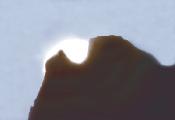Kokino -- Rock Outcrop in Macedonia
  In 2001, archeologist Jovica Stankovski discovered an archeological site from the Bronze Age on the footpath of a mountain peak near the village of Kokino. The site has a stately dimension and is scaled on two levels. Several stone seats (thrones) are dominant on the site and they are pointing towards the east horizon. In 2001, archeologist Jovica Stankovski discovered an archeological site from the Bronze Age on the footpath of a mountain peak near the village of Kokino. The site has a stately dimension and is scaled on two levels. Several stone seats (thrones) are dominant on the site and they are pointing towards the east horizon.
It was discovered that the site was used as an observatory in the course of the whole second millennium B.C., which indicates a high level of cultural progress and social organization of the inhabitants who used the observatory.
The high concentration of movable archaeological material found on the upper platform probably indicates its use in a function which so far remains unknown cult activities. The disposition and the concept of the whole site itself speak of the use of the locality as a Peak Sanctuary.
Precise measurement and detail archaeo-astronomical analyses of the site, preformed in the past two years by Gjore Cenev, physicist from Skopje Planetarium, have shown that the site has the characteristics of a sacred site, but also of a Megalithic Observatory.
  Special markers of stone have been found, used for marking all characteristics points of the movement of the Sun and Moon on the east horizon. The observatory used a method of stationary observation, marking positions of the Sun at the winter and summer solstice, as well as the equinox. Special markers of stone have been found, used for marking all characteristics points of the movement of the Sun and Moon on the east horizon. The observatory used a method of stationary observation, marking positions of the Sun at the winter and summer solstice, as well as the equinox.
Beside positions of winter and summer solstice, points of maximum and minimum digressions of the Moon are accordingly marked, as well. Analysis showed that days when special rituals were held, especially those of the harvest, were marked in a most appropriate way. Evidence of this can be found in huge number of archeological findings of terracotta, especially large number of manual mills for grain.
One specially positioned marker is very interesting because it shows that from this observatory they followed the movement of the star cluster Pleiades. According to the Sun coordinates in solstice points, as well as found terracotta, it was determined that the observatory is from 1800 B.C.
Written by Gjore Cenev
Source: megalithic.co.uk
back |